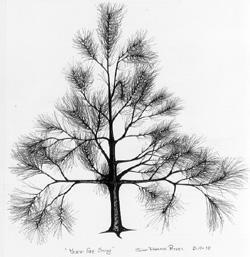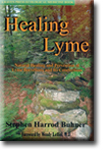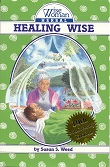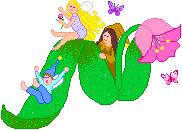Herbal Adventures with Susun S Weed
The Liliacea family - lily family
by Susun S. Weed
read other Herbal Adventures part 1, part 2 , part 3 , part 4
as seen printed in Sagewoman magazine
Welcome back and merry meet. Welcome to people's medicine, herbal medicine, your medicine, given as a gift of love from Mama Earth to us.  Speaking of love, I love the Liliacea (lily) family. From the first snowdrops, right through to autumn blooming crocuses, my garden, my life, and my health are brightened and made more beautiful by this charming family.
Speaking of love, I love the Liliacea (lily) family. From the first snowdrops, right through to autumn blooming crocuses, my garden, my life, and my health are brightened and made more beautiful by this charming family.
The Liliacea family includes such well-know edible, medicinal, and decorative plants as onions, leeks, garlic, chives, asparagus, yucca, agave, daylilies, tulips, amaryllis, hyacinths, daffodils, tiger lilies, Easter lilies, oriental lilies, camas lilies, dogtooth violets, fritillary, lily-of-the-valley, Solomon seal, trilliums, greenbriar, and aloes, including aloe vera.
What do all these plants have in common? Long, narrow, strap-like leaves, flowers with three petals and three sepals which are usually the same color as the petals (the sepals of most other flowers are green), and a storage organ above the roots called a bulb.
I've never been in any garden, anywhere in the world, that doesn't have at least one -- if not cultivated, then wild -- Liliacea member in it; and most, like mine, boast numerous representatives of the lovely lily family. All of the more than 3700 Liliacea species have beautiful flowers. (Which hybridize easily, thus the ever-changing offerings of the bulb sellers.) Some are superbly edible, but -- watch out -- some are mortally poisonous. And it isn't easy to tell the tasty ones from the deadly ones. One guideline cautions us to eat only those lily family members whose flowers open up, as daylilies do; but for safety sake, ask other wise wild women what lilies they safely eat.
Daylily (Hemerocallis) flowers are an ancient Chinese medicine, used for more than two thousand years to help women with mastitis and breast cancer. The roots also have an established scientific reputation -- for their antibacterial, anti-parasitical, and diuretic actions. I have eaten all parts of the day lily: the roots, cooked; the white part of the leaves chopped into salads; the flowers and flower buds cooked and in salads. And I find all parts laxative if overindulged in; any more than one flower or root a day is too much for my bowels. (Note: A few sources put daylilies in their own family, the Hemerocallidacea.)
Most Liliacea flowers can be eaten, with the exception of death camas, of course. I especially like wild leek or chive blossoms mixed with cottage cheese or yogurt cheese and spread on toast. In the spring, I enjoy tulip petals in my salad, but leave the daffodils strictly alone. It is said that the Dutch ate tulips bulbs to stay alive during World War II, and the botanical name Tulipa edulis seems to bear this out, but some authors are adamant that doing so will kill you, slowly, so I'll stick to garlic and onions when I want to eat lily family bulbs.
Garlic -- the stinking lily -- is the most famous member of this family. It hardly needs repeating that consistent use of garlic, and to a lesser degree onions, in the daily diet has health benefits including lowering of cholesterol and blood pressure, enhancement of metabolism, rejuvenation, and the ability to improve long-standing problems. My favorite way to take garlic is as a honey. (Recipe follows.) Garlic has been scientifically shown to counter staph, strep, salmonella, and antibiotic-resistant bacterial infections, in addition to a destroying a wide variety of parasites and fungal infections. Raw garlic is a local irritant and must be used with caution least it burn the skin, the vagina, or the digestive system.
Wild leeks, ramps, or rampion are even stronger and stinkier than garlic. A Native American story follows the plight of seven women who loved to eat wild leeks, and, of course, stank. Even though they were rejected by their families and villages, they could not stop eating those delicious ramps. Finally, the earth itself, unable to stand the smell of their breath any longer, blew the seven women up into the sky. We call them the Pleiades, and they are up there still, cooking and eating rampion to their heart's content.
When I ask myself why women might like leeks (and garlic and onions) so much that they would give up their families and homes, I realized that, like most sweet-tasting storage organs in the plant world (such as wild yam roots), Liliacea bulbs are a good source of the hormonal precursors that women frequently need to be in optimum health. (And it is true that chewing on a sprig of parsley will clear the smell of garlic from your breath, so no excuses.)
Onions are medicinal, too. A German researcher found that taking one tablespoonful of onion juice -- made by collecting the freely-dripping juice from a grated onion -- for each 75 pounds of body weight before exposure to irritants cut asthmatic symptoms by half for most people. It appears to work by countering bronchial spasms. Onion honey, like garlic honey, is great first aid for those suffering from colds and the flu, sore throats and coughs.
The lily family is richly diverse, spanning frost-hardy bulbs to desert denizens, single flowers to massive stalks covered with hundreds of blooms, and thin fibrous leaves to fleshy ones with soothing properties, like those of agave and aloe vera.
Aloe vera is a simple, effective medicinal plant that is easy to grow or buy. The gel of an aloe leaf is my favorite second-aid for a burn. (First-aid is cold water or ice, followed by aloe.) If the aloe leaf gel is renewed as soon as there is sensation of pain, even the worst burns heal with virtually no scars.  Liquid aloe vera gel, sold at natural food stores, can be transferred to a spray bottle and used liberally to protect skin from the sun, or help heal it if you do get too much. I rarely use aloe internally, finding it too laxative in action for most people.
Liquid aloe vera gel, sold at natural food stores, can be transferred to a spray bottle and used liberally to protect skin from the sun, or help heal it if you do get too much. I rarely use aloe internally, finding it too laxative in action for most people.
Learning about plant families brings herbal medicine into our everyday lives, where it belongs.When we reconnect with green medicine, our eyes and hearts take in the abundance of nourishment, beauty, and medicine that surrounds us and we find a deep feeling of peace, a sense of contentment, the thrill and joy of life, and perhaps even the urge to be a little wild. The lily family is a great place to start, or continue, your wild herbal adventures. I'll join you again in the next issue for more fun with plant families, and lots more green blessings.
Garlic/Onion Honey
Fill a jar with unpeeled garlic cloves or with garlic cloves plus a few very small onions cut in half. Fill jar to the top with honey. Cap well; label; and place in a dish. This tonic is ready to use in two days and may be taken by the teaspoonful to counter colds, flu, arthritis pain, digestive distress, sore throat, coughs, and blood vessel disease. Good for a year.
Medicinal Liliaceae
Aloe (Aloe vera) gel: Soothes and heals burns, mucus surfaces, intestines.
Asparagus (Asparagus officinalis) shoots cooked, or tea of the ferny tops, or tincture of the root: Urinary tonic, diuretic, strengthener of women, "nourisher of compassion."
Agave (Agave) leaf juice or tincture: Antiseptic, diuretic, digestive; root tincture eases joint pain.
Birth root (Trillium): Rare plant; use only as needed as a birthing aid or emmenagogue.
Daffodil (Narcissus) bulbs crushed and mixed with honey: External use only to relieve joint swelling and pain, burns, heel spurs, and earache.
False hellebore (Veratrum viride): Dangerous cardiac relaxant.
Garlic (Allium sativa) raw, cooked, powdered, or in honey: Anti-cholesterol, anti-hypertensive, antibacterial, alterative, adaptogen, longevity aid.
Greenbriar (Smilax) root tea: Gelatinous, carminative, diaphoretic, diuretic. Tender shoots, leaves, and tendrils are delicious cooked.
Onion (Allium cepa) raw, cooked, or in honey: Digestive, carminative, expectorant.
Solomon seal (Polygonatum officinale) root tea: Mucilaginous, demulcent, expectorant, heart tonic, eases diabetes, promotes healing of broken bones.
Tulip (Tulipa) bulbs crushed and mixed with honey: External use only to relieve noxious swellings such as boils, ulcers (decubita), lymphatic nodules, and cancers.
Yucca (Yucca) dried root tea or capsules: Anti-inflammatory, anti-acid, anti-arthritic. Fresh flowers are a delicious edible.
 Green blessings. Susun
Green blessings. Susun
Healing Lyme:
Natural Healing and Prevention of Lyme Borreliosis and Its Coinfections
by Stephen Harrod Buhner
Healing Lyme examines the leading, scientific research on Lyme infection, its tests and treatments, and outlines the most potent herbal medicines and supplements that offer help, either alone or in combination with antibiotics, for preventing and healing the disease. It is the essential guide to Lyme infection and its treatment.
Paperback, 272pp
"The first 75 pages are as good a review of the scientific literature as I've seen. . . I was impressed by [Buhner's] grasp of the literature. He really did his homework." - Richard Horowitz, President ILADS.
Price: $19.95
Order Healing Lyme in our Bookshop
Healing
Wise
 by Susun
S. Weed
by Susun
S. Weed
Introduction by Jean Houston.
Superb herbal in the feminine-intuitive mode. Complete instructions for using common plants for food, beauty, medicine, and longevity. Seven herbs -- burdock, chickweed, dandelion, nettle,
oatstraw, seaweed, and violet -- are explored in depth.
A Special Tenth Anniversary edition of this
classic herbal, profusely illustrated. 312 pages.
Retails for $21.95
Read a Review
Order HEALING WISE in our Bookshop
I just started reading your book, Healing Wise. Your
humor and approach to life seem so "down-to-earth",
just like your favorite powerful weeds. Thank you for sharing
and nourishing.! ~ Diane







